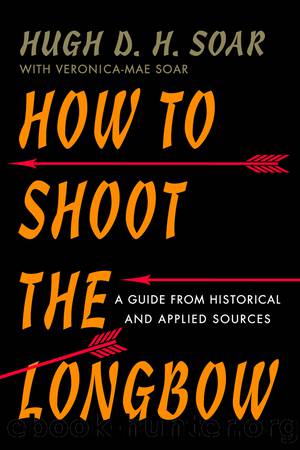How to Shoot the Longbow by Soar Hugh D. H.;Spears Lorén;

Author:Soar, Hugh D. H.;Spears, Lorén; [Soar, Hugh D. H.]
Language: eng
Format: epub
Publisher: Westholme Publishing
Twenty-four bracers were recovered from the warship and of these twenty-one are more or less whole; the remaining three are fragmentary and include one of horn. With the exception of one of ivory, the complete ones are all of leather, mostly bovine.
A bracer or arm-guard probably remained with an archer during his whole shooting life, and any decoration present might reveal something of his personality, or his affiliation. Thus, religious symbolism in the form of a crucifixion appears on one and Marion aves on two others. Association with a guild is suggested by at least one, where a grid-iron symbol of the Girdlers Company is stamped. St Peterâs keysâsymbol of Exeter Cathedralâmay indicate the origin of the owner, while at least two, and possibly others have royal insignia. The rose appears on several, suggestive of the Tudor emblem, or even personalized association with the ship.
Of particular interest is an ivory example, a fine and unique piece which was found attached to a right forearm. The bracer was however small, as was its wearer. If the owner were indeed an archer then this would indicate left-handednessânot a welcome characteristic at any time, and especially so on board ship. The circumstance is a little perplexing.
And so, with an unsolved Tudor puzzle behind us we will slip forward into the seventeenth century and, sadly, to a dearth of equipment for study.
The glut of sixteenth-century archery material available for study leaves us ill-prepared for the paucity that is to follow. For although recreational archery thrived, at least for a time, through the support and personal interest of King Charles II and the activity of the Society of Finsbury Archersâjust one item of consequence remains to intrigue. This, the Renishaw Hall bow, whose early history is largely undocumented and which was known for many years as âRobin Hoodâs Bow,â we will now consider; and we will draw upon a monograph prepared for the Society of Archer Antiquaries in 2011 by member Michael Leach.12
The bow is laminated and consists of a yew belly, a back believed to be hickory and a core laminate that may be of wych elm. The tips are damaged and there are no stringing horns, although there is evidence for cone shaped ends that, undamaged, could have accommodated them. The length now is 68 inches, suggesting an original length of 70 inches. There is evidence for scarfing of the core laminate, a feature of some later, eighteenth century bows; however the weapon is known to have been damaged when dropped in 1949 and this may reflect repair work then.
Of particular interest is the presence of a number of small indents forming a âsteepleâ pattern on the upper limb by the arrow pass. These show similarity with bowyers marks previously noted on sixteenth century bows where they seem to indicate the upper limb and also perhaps identify the maker; their presence on the Renishaw bow may thus be the mark of a Yorkshire bow maker. In addition, the back of each limb has
Download
This site does not store any files on its server. We only index and link to content provided by other sites. Please contact the content providers to delete copyright contents if any and email us, we'll remove relevant links or contents immediately.
Shoe Dog by Phil Knight(5217)
The Rules Do Not Apply by Ariel Levy(4910)
Walking by Henry David Thoreau(3923)
How to Read Water: Clues and Patterns from Puddles to the Sea (Natural Navigation) by Tristan Gooley(3433)
Running Barefoot by Amy Harmon(3415)
I'll Give You the Sun by Jandy Nelson(3394)
Crazy Is My Superpower by A.J. Mendez Brooks(3359)
How to Read Nature by Tristan Gooley(3292)
How Music Works by David Byrne(3234)
The Boy, the Mole, the Fox and the Horse by Charlie Mackesy(3065)
The Fight by Norman Mailer(2887)
Seducing Cinderella by Gina L. Maxwell(2618)
Cuba by Lonely Planet(2600)
Accepted by Pat Patterson(2336)
Going Long by Editors of Runner's World(2327)
The Unfettered Mind: Writings from a Zen Master to a Master Swordsman by Takuan Soho(2272)
The Happy Runner by David Roche(2213)
Backpacker the Complete Guide to Backpacking by Backpacker Magazine(2212)
Trail Magic by Trevelyan Quest Edwards & Hazel Edwards(2143)
